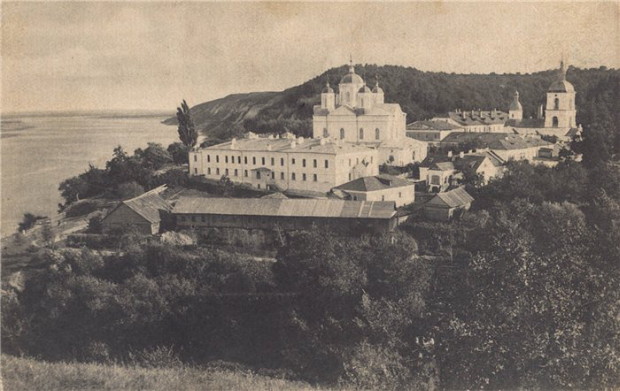Mezhyhiria Transfiguration Monastery
Mezhyhiria Transfiguration Monastery (Межигірський Спасо-Преображенський манастир; Mezhyhirskyi Spaso-Preobrazhenskyi manastyr). An orthodox men's monastery located in Novi Petrivtsi (formerly Mezhyhiria), near Vyshhorod, 20 km north of Kyiv. According to some accounts, it was founded by Greek monks from Mount Athos who arrived in Kyiv at the time of the Christianization of Ukraine in 988. Prince Andrei Bogoliubskii allegedly moved it to a more favorable location (hence its name, which means ‘between the hills’). According to these accounts, it was destroyed during the Mongol invasion of 1240.
The first written records of the monastery date from 1523, when it was granted a royal charter. Soon after it ceased to exist, but it was renewed under the Greek monk Athanasius, with the backing of Isaia Kopynsky. It grew quickly and by the mid-17th century had 150 monks. In 1665 it was partially destroyed by a fire, but its growth resumed soon after. In 1687 it was granted stauropegion.
The Mezhyhiria monastery was long known as the ‘Cossack military monastery’ because of its close association with the Cossacks. They were important benefactors, and many of them retired to the monastery. From 1683 all clergymen assigned to the Zaporozhian Sich had to come from there. Supported generously by hetmans (esp Ivan Mazepa), magnates, metropolitans, and the Zaporozhian Sich (which funded a military hospital there), the monastery became one of the wealthiest in Ukraine. The Mezhyhiria Chronicle, a history of the Volhynia and Kyiv regions in the 14th to 17th centuries, was probably written by a monk at the monastery. Monks from Mezhyhiria also assisted in the establishment of other monasteries, notably the Mhar Transfiguration Monastery and the Hustynia Trinity Monastery.
The main buildings of the complex were built in the late 17th to early 18th centuries. These included the Church of the Transfiguration (1690), from which the monastery took its name; the Church of Saints Peter and Paul (1768–74, funded by Petro Kalnyshevsky); the bell tower; and the monks' cells (designed by Ivan Hryhorovych-Barsky, 1766, rebuilt 1816–17). In 1786 the Russian government closed the monastery and nationalized its extensive landholdings, and in 1787 a massive fire gutted the main buildings. In place of the monastery the Mezhyhiria Faience Factory was opened in 1798. The monastery was reopened in 1886; in 1908 it housed 14 monks and 23 novices. In the early 1920s the Soviet authorities confiscated its valuables and dispersed its monks, and established the Mezhyhiria Ceramics Tekhnikum in its place that later, under the directorship of Vasyl Sedliar, became an important artistic and educational center of the artists from Mykhailo Boichuk’s school.
In the 1930s, under the pretext of ‘development of the Mezhyhiria area,’ the main buildings of the monastery were destroyed, and dachas for Communist Party leaders were built in their place.
Ivan Korovytsky
[This article was updated in 2011.]
.jpg)

.jpg)